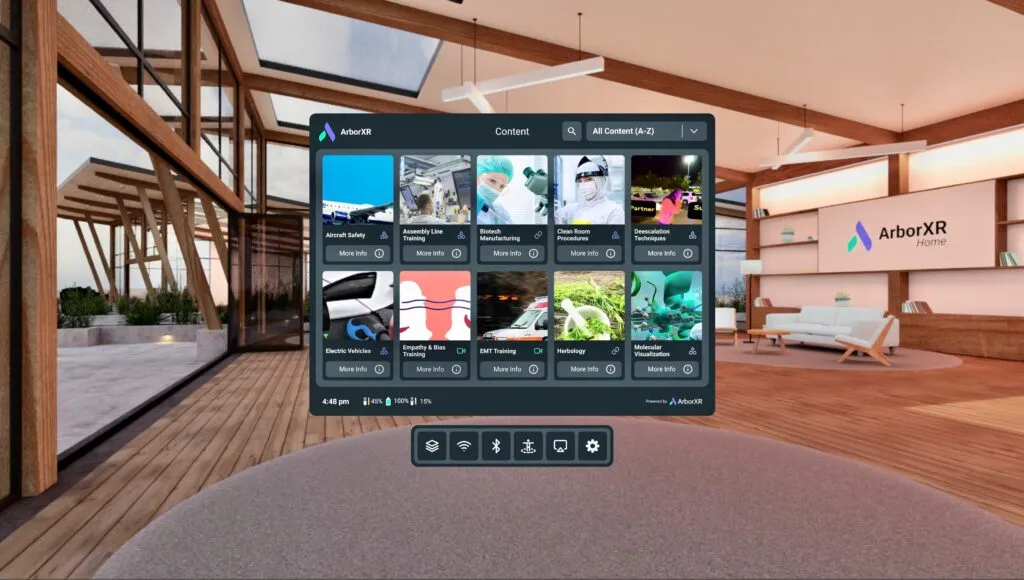VR training is changing how companies develop their teams.
According to PwC’s Metaverse Survey, 51% of companies are now integrating VR into their strategy or have already built VR into at least one business line. From healthcare to recruitment and onboarding, VR is creating hands-on, immersive learning experiences that are safe, repeatable, and engaging.
In this ArborXR article, we’ll explore real-world VR training examples, showing how it’s helping businesses across different industries tackle big challenges and boost skills.
7 Real-World Examples of VR Training
1. VR Training for Healthcare and Surgery
Healthcare providers increasingly use VR to train doctors and surgeons.
Instead of practicing on live patients, medical professionals can master complex procedures in risk-free VR simulations. This approach improves precision and confidence while allowing doctors to practice rare cases they might rarely encounter with actual patients.
Virtual reality surgery training offers several key benefits:
- Cost and Time Efficiency: VR training reduces expenses compared to traditional methods
- Better Retention: Doctors maintain their skills longer with VR practice
- Customization: Programs can be tailored to specific medical procedures
Imperial College London Uses VR Training to Reduce Errors in Surgery
At Imperial College London, VR training dramatically improved surgical outcomes: 83% of VR-trained residents successfully performed new procedures, while traditionally trained residents couldn't match this performance level.
While VR clearly enhances surgical training, device management poses challenges. Hospitals struggle to manage content, update devices, and control user experiences, especially across large facilities or rural locations. Often, VR devices don't function properly in these settings.ArborXR addresses these challenges with our XR device management platform.

We enable remote enrollment and management of XR devices including Meta (Oculus), PICO, HTC VIVE, Vuzix, and DPVR. Our platform provides scalable content deployment, remote updates, and device tracking capabilities.
2. VR Training for Defence and Military Training
The defense sector is increasingly using VR to enhance training for military personnel.
VR offers a safe environment for soldiers to practice combat scenarios, tactical operations, and crisis management. It provides realistic simulations that can be tailored to various situations, such as urban warfare or counterterrorism operations.
VR also significantly reduces the need for physical resources like vehicles and equipment. Units across different locations can train consistently at scale, creating a more efficient and cost-effective training program.
U.S. Army's Synthetic Training Environment (STE) at Fort Hood
In 2022, the U.S. Army tested its Synthetic Training Environment at Fort Hood with 150 soldiers. The program blended virtual, live, and collective training elements into a portable, realistic experience designed to drive rapid improvement.
Soldiers could rehearse missions and train across multiple functions in virtual environments that replicated real-world terrain—all without the usual resource demands of traditional training (e.g., travel, fuel, ammunition, etc.).
3. VR Training for Informal Education
VR is also transforming informal education by bringing lessons to life beyond traditional classrooms.
Students in after-school programs and vocational training can explore new fields and develop practical skills through immersive experiences. This flexible approach lets students learn at their own pace, anywhere and anytime.
The technology eliminates costs for physical materials and travel while creating experiences that would be difficult or impossible to replicate in traditional settings.
WECA Closes the Skilled Trades Gap with VR Training
The Western Equipment Dealers Association (WECA) is using VR to close the skilled trades gap by offering custom training solutions.

Using ArborXR's device management platform, WECA has trained over 1,200 apprentices in electrical courses, with 160 students completing the program within eight months of its 2023 launch. The ArborXR Home feature gave them enhanced control over the learning environment, laying the groundwork for continued program refinement and expansion.
4. VR Training for Employees Onboarding and Training
VR training has made a significant impact on employee onboarding and training, offering a dynamic and engaging way to prepare new hires.
Traditional onboarding and training methods can be monotonous, involving paperwork and basic introductions, but VR transforms this process into an interactive, immersive experience.
VR can simulate real-world work environments, helping new employees better understand their roles and responsibilities and how best to deliver on them. It also offers faster integration and consistency, ensuring every employee gets the same experience.
One excellent example of an organization that has leveraged VR training for employee onboarding and training is Bank of America.
Bank of America Enhances Employee Development
Bank of America leveraged ArborXR’s platform to power immersive onboarding and skills training for its employees. With VR environments like a virtual Bank of America world and the AI-powered “iCoach” tool, new hires and seasoned employees can practice real-world scenarios safely.

ArborXR enables secure content distribution and user management, helping Bank of America scale its VR program to benefit its 200,000-person workforce. In the end, 97% of employees felt confident about applying their VR-learned skills.
5. VR Training for Users and Clients
VR isn’t just for internal training—it’s also reshaping how companies engage and train their clients, users, and customers. By offering immersive, hands-on experiences, VR allows users to interact with products in ways that feel real.
This helps clients gain confidence, better understand complex offerings, and make more informed decisions. Industries like software, healthcare, and retail are leading the way in using VR to enhance user experiences.
It also offers other benefits, such as:
- Building customer confidence by letting them try products in lifelike settings.
- Cutting down training time and costs for companies.
- Letting users learn at their own pace, improving satisfaction and retention.
IKEA Uses VR to Train Clients on Possible Interior Arrangements
IKEA uses VR to help customers visualize how furniture will look and fit in their homes before making a purchase.
The AI-driven digital design experience, IKEA Kreativ, enables customers to use VR headsets to explore the product catalog in VR, trying out items in realistic spaces. They can move, rotate, stack, and hang furniture to see how different options fit and look together, helping them find the perfect pieces for their needs.
This immersive experience helps customers make more informed decisions and enhances their shopping experience.
6. VR Training in Sport
Sport is another area where VR training is finding extensive applications. Athletes can now practice skills, visualize plays, and improve techniques–all without stepping onto a field. It also lets staff and coaches analyze their performance, run simulations, and refine strategies in a safe, controlled environment.
Other advantages include:
- Boosting athlete performance by enabling detailed, repeatable practice.
- Allowing mental rehearsal of game scenarios and strategies.
- Reducing injury risk by offering a low-impact way to train.
SmartTek’s VR Baseball Game
For example, SmartTek Solutions developed a VR baseball game to help players improve their batting skills.
The game simulates a real baseball environment where players can practice hitting pitches, refining their reactions and timing. This innovative training tool allows athletes to work on specific techniques in a risk-free, immersive environment.
Looking to develop your own VR training apps for sports or other industries? ArborXR's XR Directory connects you with expert developers who specialize in custom XR content and experiences, from skill training to fan engagement, helping bring your vision to life.
7. VR Training in Construction
In construction, safety is everything. VR training is transforming the construction industry by making training safer and more effective.
Here’s how:
- Safety First: Workers can practice high-risk tasks in a virtual environment, avoiding real-world accidents.
- Skill Mastery: Complex procedures are easier to repeat and refine until trainees master them.
- Remote Collaboration: Teams across different locations can train together, improving coordination.
- Speed and Efficiency: VR helps workers gain necessary skills faster, reducing training time.
By using VR, companies reduce accidents, improve safety, and save on physical training resources. It’s a smart way to help workers get ready for tough situations while avoiding real-life consequences.
OutHere and Skanska Safety-Focused Virtual Reality Training
Skanska, a global construction company, partnered with OutHere to improve worker training using VR technology.
They developed VR safety training apps using Unity’s technology and the HTC Vive platform. The goal was to reduce accidents and create safer construction sites. The VR training improved safety awareness and successfully reduced accidents, showcasing the effectiveness of immersive training solutions.
Enhance Your VR Training Programs with ArborXR
VR training is changing how industries train, from healthcare to construction. It makes learning more hands-on, boosts engagement, and improves retention. But to get the most out of VR, you need the right tools to manage devices and content effectively.
That’s where ArborXR comes in. We simplify managing XR devices, delivering content, and controlling user experiences—making your VR training more effective, scalable, and seamless.Want to take your VR training to the next level? Get started today.

